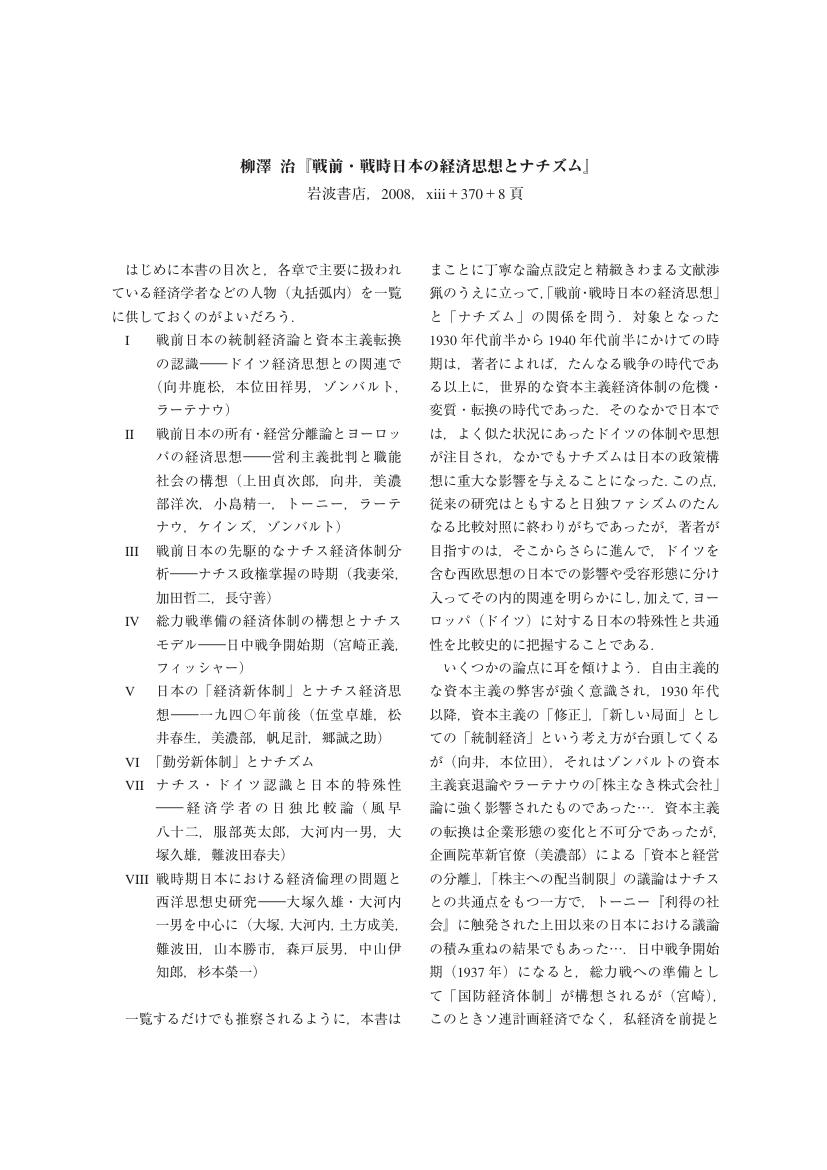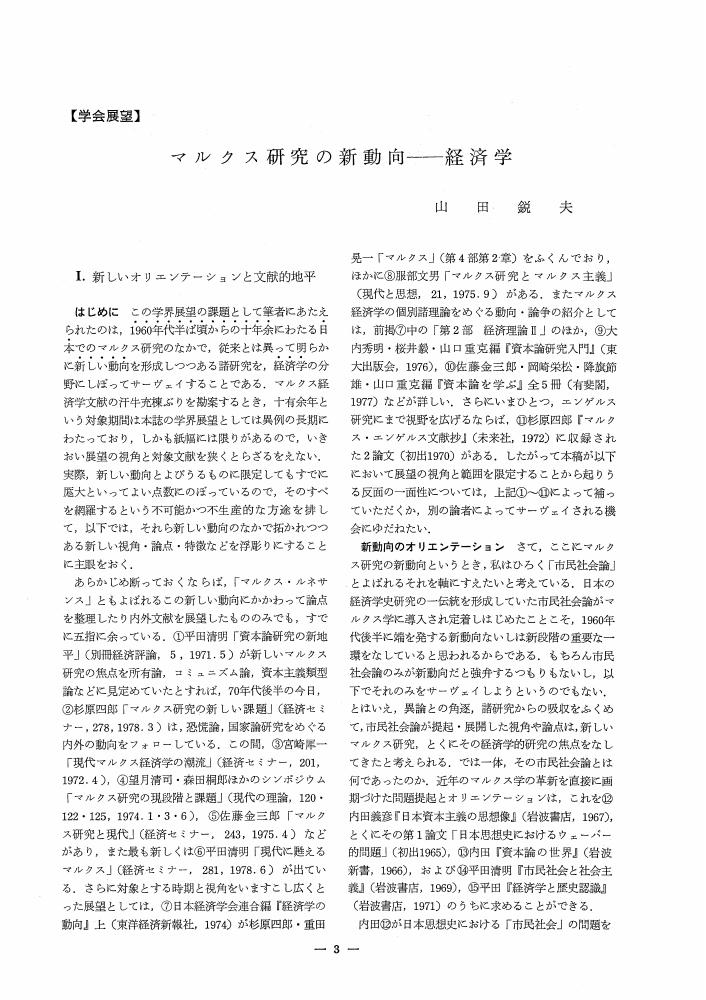- 著者
- 山田 鋭夫
- 出版者
- 経済理論学会
- 雑誌
- 季刊経済理論 (ISSN:18825184)
- 巻号頁・発行日
- vol.55, no.1, pp.72, 2018 (Released:2020-04-13)
2 0 0 0 OA 資本主義経済における多様性
- 著者
- 山田 鋭夫
- 出版者
- Japan Association for Comparative Economic Studies
- 雑誌
- 比較経済研究 (ISSN:18805647)
- 巻号頁・発行日
- vol.44, no.1, pp.15-28,101, 2007-01-31 (Released:2009-07-31)
- 参考文献数
- 23
- 被引用文献数
- 2 3
本稿は資本主義経済をその制度的多様性の観点から類型化し,その意味を問う。これに関する研究として,1990年代以降,2類型論と5類型論という2大所説が展開されている。その議論を整理しつつ,そこで原理的に問われているものとして,「資本原理と社会原理の対抗と補完」および「社会的調整の多様性」という論点を取り出し,もって資本主義多様性論に関する有効な分析視角を提起する。
- 著者
- 山田 鋭夫
- 出版者
- 経済学史学会
- 雑誌
- 経済学史研究 (ISSN:18803164)
- 巻号頁・発行日
- vol.58, no.2, pp.57-59, 2017 (Released:2019-11-30)
1 0 0 0 OA 旧帝国主義批判の書としての『国富論』
- 著者
- 山田 鋭夫 Robert Chapeskie
- 出版者
- The Japanease Society for the History of Economic Thought
- 雑誌
- 経済学史研究 (ISSN:18803164)
- 巻号頁・発行日
- vol.58, no.2, pp.1-23, 2017 (Released:2019-08-31)
- 被引用文献数
- 3
Introduction by Toshio Yamada This text was originally a chapter in Yoshihiko Uchidaʼs (1913-1989) first book, The Birth of Economic Science (hereafter referred to as “Birth”), Tokyo: Mirai-sha Publishers, 1953, and was later included in Collected Works of Yoshi-hiko Uchida, vol. 1, Tokyo: Iwanami Shoten, Publishers, 1989. Birth was pub-lished eight years after Japanʼs defeat in World War II, in the era of chaos and hope that followed this conflict. It has been widely read by generations of social scientists, and is now considered one of the greatest masterpieces in the study of Adam Smith in Japan. Following its somewhat lengthy “Introduction,” Uchidaʼs Birth is construct-ed in two parts: Part One, “The Birth of Economic Science: Wealth of Nations as a Critique of the Old Imperial System” and Part Two, “Analysis of the Sys-tem of Wealth of Nations.” In Part One, Uchida depicts the birth of economic science in Smith not as an extension of political economy after the mercantile system but rather as a critical response to the examination of civil society found in thinkers such as John Locke, David Hume and above all Jean-Jacques Rous-seau, thus bringing into sharp relief Adam Smith as a thinker who criticized mercantilist “modernization from above.” In Part Two, starting with an examina-tion of Smithʼs concept of civil society and theory of the division of labor, Uchi-da analyzes his theories of value, surplus value, and capital accumulation and reproduction by contrasting them with those of Karl Marx. For a more detailed outline of Birth, see Sakamoto (2017).
- 著者
- 山田 鋭夫
- 出版者
- The Japanease Society for the History of Economic Thought
- 雑誌
- 経済学史研究 (ISSN:18803164)
- 巻号頁・発行日
- vol.56, no.1, pp.1-20, 2014 (Released:2019-08-24)
Abstract: Hirata Kiyoaki is a representative historian of economic thought in postwar Japan, a renova-tor of Marxism, and, above all, a theoretician vis-à-vis civil society. The thinkers he principal-ly examined were Quesnay, Marx, and Gramsci. Through the study of these three theoreti-cians, his thinking on civil society germinated, fully developed, and finally experienced a sort of change. In this essay, I will follow the development of and changes in his theory, as well as his original and fundamental analytical approach with regard to economic society; in so do-ing, I wish to elucidate the contemporary significance and limits of his civil society theory. The original nature of Hirataʼs theory resides in the fact that he analyzes economic soci-ety from a “process and structure” approach. In early Hirataʼs study of Quesnay, this was ex-pressed in terms of the methodological pivot of the “circuit of productive capital and structure of reproduction,” leading to a solution of the so-called enigma of the Tableau économique. In middle-aged Hirataʼs study of Marx, he began to place the greatest analytical emphasis on the “capital circuit” or “process,” rather than on “structure.” This resulted in an exploration of problems pertaining to property: the inversion of the law of appropriation and the re-estab-lishment of individual property. Here we see the full development of his theory of civil socie-ty, which addressed many pressing questions posed with respect to actual issues of the times: civil society and community, civil society and capitalism, and civil society and socialism. Later-years Hirata adopted the Gramscian theory of hegemony, thus shifting his attention to a civil society theory that differed from that of his younger years. By stressing the Gramscian genealogy of the word régulation of the French régulation school, it seems that he had found in this concept his own approach to “process.” In other words, his initial approach to “structure,” another one in his younger days, may have gradually faded away, or his death may have hindered him from the active development of this approach. However, as a cost of it having not been developed, his thoughts on the “re-establishment of individual property”-which he substantiated as part of his approach to “process”-have become something that does retain universal value even today. JEL classification numbers: B 14, B 31, B 52.
- 著者
- 山田 鋭夫
- 出版者
- 経済学史学会
- 雑誌
- 経済学史研究 (ISSN:18803164)
- 巻号頁・発行日
- vol.51, no.1, pp.119-120, 2009 (Released:2019-06-22)
- 著者
- 山田 鋭夫
- 出版者
- The Japanese Society for the History of Economic Thought
- 雑誌
- 経済学史学会年報 (ISSN:04534786)
- 巻号頁・発行日
- vol.25, no.25, pp.74, 1987 (Released:2010-08-05)
1 0 0 0 OA マルクス研究の新動向-経済学
- 著者
- 山田 鋭夫
- 出版者
- The Japanese Society for the History of Economic Thought
- 雑誌
- 経済学史学会年報 (ISSN:04534786)
- 巻号頁・発行日
- vol.16, no.16, pp.3-12, 1978 (Released:2010-08-05)




